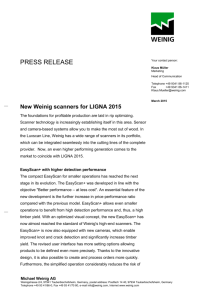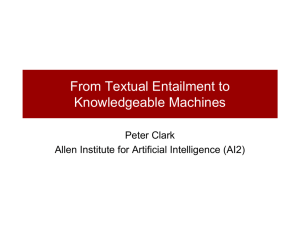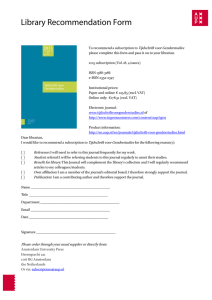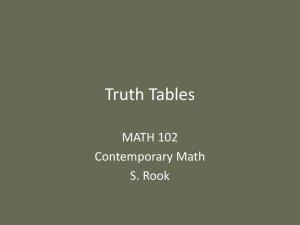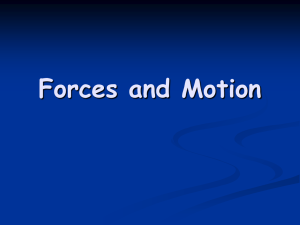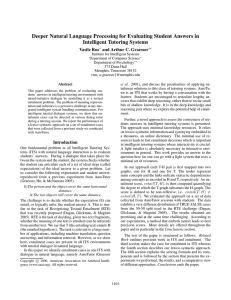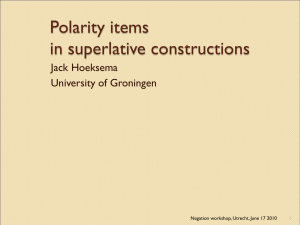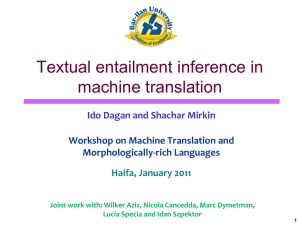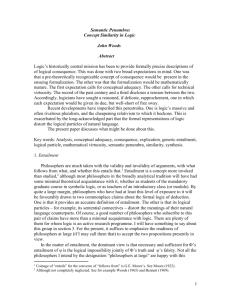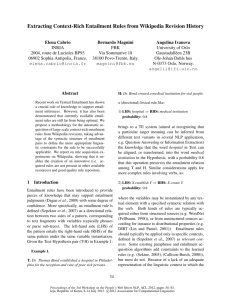Negative Polarity Items and Downward Entailment
advertisement
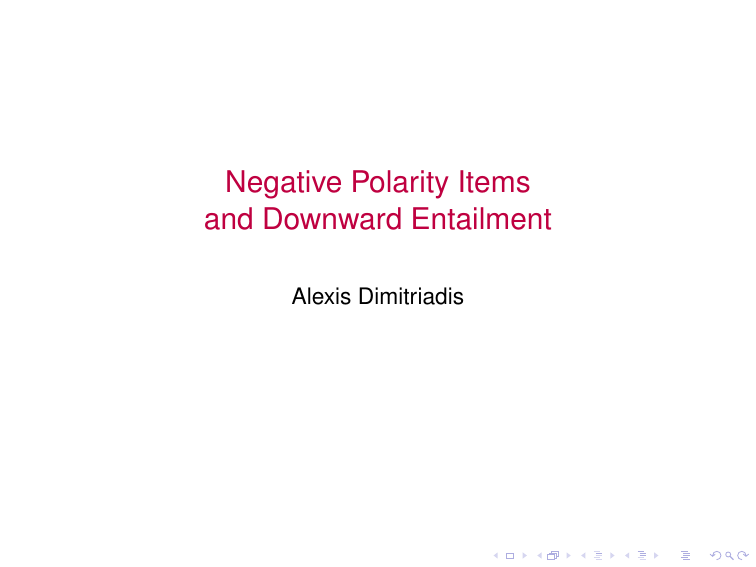
Negative Polarity Items and Downward Entailment Alexis Dimitriadis Negative polarity items I • Expressions like any, ever, a red cent or give a damn are “restricted in their distribution”: (1) a. * I’ve seen anything. b. I haven’t seen anything. (2) a. * John has ever been to Paris. b. John hasn’t ever been to Paris. (3) a. * Mary has a red cent. b. Mary doesn’t have a red cent. (4) a. * Tina gives a damn about your problems. b. Tina doesn’t give a damn about your problems. Negative polarity items II • In Dutch: hoeven, kunnen uitstaan, ook maar iets, voor de poes zijn, etc. (5) a. * Je hoeft deze opgave te maken. b. Je hoeft deze opgave niet te maken. (6) a. * Mijn moeder is voor de poes. b. Mijn moeder is niet voor de poes. (7) a. * De zeug kan de boer uitstaan. b. De zeug kan de boer niet uitstaan. • Roughly: NPIs are somehow “licensed” by negation. Is it negation? I (8) a. De zeug kan de boer niet uitstaan. ...but also: b. De zeug kan maar weinig mensen uitstaan. c. De zeug kan de boer zelden uitstaan. d. * De zeug kan de boer (vaak/meestal) uitstaan. (9) a. Mijn moeder is niet voor de poes. b. * Mijn moeder is zelden voor de poes. c. * Niemand is voor de poes. d. * Weinig mensen zijn voor de poes. Is it negation? II (10) a. Nobody has seen anything. b. My mother seldom sees anything. c. * My mother has seen anything. d. e. Everyone who saw anything should call the police. * Everyone who saw him should say anything. Is it negation? II (10) a. Nobody has seen anything. b. My mother seldom sees anything. c. * My mother has seen anything. d. e. • Everyone who saw anything should call the police. * Everyone who saw him should say anything. Other environments also license NPIs: everyone, weinig, zelden, ... Is it negation? II (10) a. Nobody has seen anything. b. My mother seldom sees anything. c. * My mother has seen anything. d. e. • Everyone who saw anything should call the police. * Everyone who saw him should say anything. Other environments also license NPIs: everyone, weinig, zelden, ... • NPIs must be in the scope of a licenser. [ Everyone who saw anything ] should call the police. Downward entailment I • Ladusaw / Fauconnier: NPIs are licensed in downward entailing (downward monotonic) environments. • Regular (“upward” entailment): If P ⊆ S (as sets), P(x) =⇒ S(x) (11) • John is Dutch =⇒ John is European. Negation reverses the implication: “downward” entailment. (12) a. John is not Dutch =⇒ 6 John is not European. b. John is not European =⇒ John is not Dutch. Downward entailment II Formal definition • A function f is upward entailing iff for every X , Y : if X ≤ Y , then f (X ) ≤ f (Y ). • A function f is downward entailing iff for every X , Y : if X ≤ Y , then f (Y ) ≤ f (X ). • Note that some environments block such entailments: (13) John thinks that Mary is Greek. =⇒ 6 John thinks that Mary is European. (Maybe John thinks that Greece is in Asia.) Testing downward entailment (14) Negation: I did not walk =⇒ I did not walk quickly (15) Conditional sentence antecedent: [ If you talk ], you should leave =⇒ [ If you talk loud ], you should leave. (16) Comparative of inequality: Obelix is stronger than [ a soldier can be ] =⇒ Obelix is stronger than [ a Roman soldier can be ] Which of these are DE? 1 Comparatives of equality Obelix is as strong as [ a soldier can be. ] 2 Conditional sentence consequent (right side) If you talk, [ you should leave ] 3 Restriction of universal (every, each, all the, any) Every [ student who came to the party ] danced. 4 Complement (“nuclear scope”) of universal Every student who came to the party [ danced. ] 5 Restriction of few Few [ students ] enjoyed the exam. Complications I • NPIs can also occur in environments that are not DE (17) Questions a. Do you know anything about this? b. Heb je ook maar iets gezien? • Similar constructions can show different licensing behavior (18) a. Every student who saw anything reported it. b. ?* Each student who saw anything reported it. Complications II • NPIs differ from each other in their licensers (19) a. Few people saw anything. b. * Weinig mensen hebben ook maar iets gezien. (20) a. Only John noticed anything b. * Only John has seen him in weeks c. I am sorry I ever met you. d. * I am sorry I recognized you until it was too late. • (Example (a) involves Strawson entailment: To get DE, we must rely on the presupposition “John noticed X”) Alternatives • The Zwarts hierarchy adds a number of stronger licensing environments to DE: 1 F is downward entailing iff for all x, y such that x =⇒ y , F (y ) =⇒ F (x). (Ladusaw 1979) 2 F is anti-additive iff for all x, y : F (x ∨ y ) = F (x) ∧ F (y ). (Zwarts 1981) 3 F is anti-multiplicative iff F (x ∧ y ) = F (x) ∨ F (y ). (Zwarts 1998) 4 F is anti-morphic iff F is anti-additive and anti-multiplicative. 5 F is nonveridical iff F (p) does not entail p. (Giannakidou 1997) The “Zwarts hierarchy” Summary: What we want to know • Which syntactic environments (constructions) license each particular NPI? (Descriptive) • What property/properties of the licensers is responsible for licensing? (Theoretical) • How do we test for downward entailment and the other properties? (Practical)

